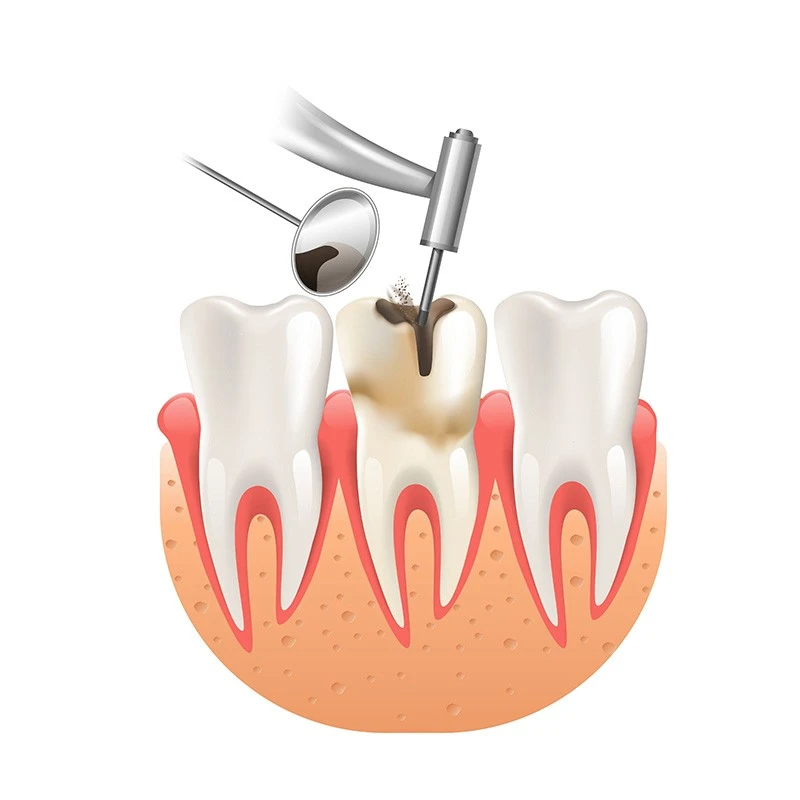
Tooth filling
is tooth filling, which is the treatment of symptoms of tooth decay. What is clearly seen is a hole, a broken tooth, or a chipped tooth, which is in the range where there has been damage only to the dentin. This is caused by many reasons, including using your teeth to crunch hard objects with too much force.
Corrosion from acidifying bacteria or other causes. These symptoms will lead to problems with using the teeth to chew food. and will result in the spread of even more tooth damage. Therefore, correction is necessary. By filling the tooth, the tooth will be restored to its full potential and function as efficiently as before.
How many types of tooth fillings are there?
We divide tooth fillings according to the type of material used into two types.
1.Teeth filled with amalgam. Amalgam is made from a combination of mercury, silver, tin, or other metals. It is a tooth filling material that has a metallic color. In the past, it was commonly used to fill back teeth such as molars and premolars because of their strength. Resistant to chewing force well Can be used for up to 10–15 years.
2.Tooth filling made from composite resin (composite resin). Tooth filling material is made from composite resin. Color similar to natural teeth Therefore, it is commonly used to fill the front teeth for beauty. Later, composite resins were developed to be stronger. Therefore, it can also be used to fill back teeth.
3.Glass ionomer cement is commonly used as a dental filling for young children. and those at risk for tooth decay Because glass ionomers can release fluoride to prevent tooth decay, there are also other types of filling materials, such as gold and porcelain.
Basically, tooth filling It is a replacement for lost tooth pulp with filling materials. Fill in the tooth pulp to return it to its normal shape. Used to chew food efficiently and give beauty Especially in the case of a patient with a chipped front tooth.
Filling the tooth will help block the passage so that bacteria or food particles cannot fall into the tooth cavity. Until there is more inflammation in the tooth, leads to problems such as gingivitis, pus, tooth decay spreading to the root cavity, tooth root decay, and tooth decay.
I must say that dental amalgam fillings are less commonly used. Because it contains metal ingredients. Plus, the tooth filling process involves grinding out more tooth pulp than composite resin fillings. Patients who have amalgam fillings must refrain from chewing food on the side of the filling for 24 hours because the material is not yet hard.
What kind of filling is best?
It must be said that amalgam fillings are less commonly used. Because it contains metal ingredients. Plus, the tooth filling process involves grinding out more tooth pulp than composite resin fillings. Patients who have amalgam fillings must refrain from chewing food on the side of the filling for 24 hours because the material has not yet fully hardened.
Dental fillings with composite resin materials Tooth-colored designs are very popular in dentistry. Because there is less actual tooth grinding, the composite resin filling material has been developed to make the material stronger and more durable. and the same color as the tooth pulp for beauty. After the tooth filling is complete, the patient can chew food.
Tooth filling procedure
- Dentist examining teeth Check the condition of tooth decay. Evaluate the treatment to see if the filling can be fixed or not. The dentist will grind out the decayed and infected tooth pulp. The appearance of the tooth is soft and crumbly. The color of the tooth may change color. In this procedure, the dentist will first inject an anesthetic. To prevent tooth pain or sensitivity If the patient has deep tooth decay that almost reaches the tooth nerve cavity,
- After grinding out the tooth decay If the tooth decays deep into the inner layer of the tooth, the dentist will insert foundation material. It helps reduce tooth sensitivity.
- The dentist fills the tooth with the material used to fill the tooth.
- If it is a metal filling
- If it is a tooth-colored filling, Additional light will be given to help fill the tooth.
- Next, which may take more or less time depending on the condition of the patient's teeth.
Advantages of dental fillings
- Prevents tooth decay problems from spreading to the tooth nerve cavity.
- Reduce tooth sensitivity caused by tooth decay and inflammation.
- Fills in the dentin so that the tooth can function effectively.
- Tooth filling with tooth-colored material It helps fill in the tooth to make it beautiful and natural. build confidence
Suggestions for caring for teeth after filling a tooth
- Clean teeth Use a soft-bristled brush and brush your teeth properly.
- Use dental floss along with mouthwash that contains fluoride. It will help remove food particles that are stuck between the teeth and prevent tooth decay.
- Avoid chewing foods that are too hard, such as ice, raw carrots, and nuts.
- This may cause the material to crack or fall off.
- Avoid extremely cold or hot foods to avoid possible tooth sensitivity.
- In the case where the patient has an amalgam filling in the tooth, you must refrain from chewing with the filled tooth for 24 hours to allow the filling to fully harden.
- See a dentist to check your dental health every 6 months.
Symptoms found after filling a tooth
Patients may experience tooth sensitivity after having a filling done. But this symptom can go away on its own within 1 - 2 weeks, or you may have a toothache. You can take medicine to relieve pain, but if the symptoms do not subside or if symptoms appear abnormal, you must see a doctor immediately.
Patients with tooth fillings should return to see the dentist when
- Teeth that were previously filled are cracked or loose. You should get a new filling to prevent tooth decay from spreading to the point where it cannot be treated with a filling.
- Have tooth sensitivity for more than 2 - 3 weeks.
- Tooth pain when chewing food It may be caused by the filling material being too high.
- Severe toothache after filling It is possible that the tooth has decayed deep into the nerve cavity. You should immediately consult a dentist to receive root canal treatment.
How long have you had your tooth filled?
A tooth filling usually takes about 30 minutes, but it can take more or less time depending on the position of the tooth. Condition of the patient's decayed teeth
Does a tooth filling hurt?
During the filling process, the tooth will feel sensitive when the tooth has to be ground. If the patient has deeper tooth decay, closer to the tooth nerve cavity If you shoot, there's a chance of getting hurt a lot. But the doctor will give anesthesia to prevent pain or tooth sensitivity that may occur.
After filling a tooth, you may experience tooth sensitivity. But it will heal normally in 1–2 weeks. In the beginning, you should avoid very cold or very hot foods for now.
Teeth filled and toothache
Pain after filling a tooth is normal. Patients can take painkillers to relieve wounds and swelling. You can continue eating until the pain or sensitivity subsides, as recommended by your dentist. But if symptoms are severe, you should hurry back to see your dentist immediately.

